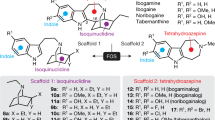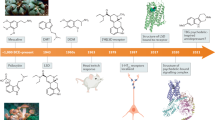Abstract
Fenethylline, also known by the trade name Captagon, is a synthetic psychoactive stimulant that has recently been linked to a substance-use disorder and ‘pharmacoterrorism’ in the Middle East1,2,3,4. Although fenethylline shares a common phenethylamine core with other amphetamine-type stimulants, it also incorporates a covalently linked xanthine moiety into its parent structure5,6. These independently active pharmacophores are liberated during metabolism, resulting in the release of a structurally diverse chemical mixture into the central nervous system7,8,9. Although the psychoactive properties of fenethylline have been reported to differ from those of other synthetic stimulants, the in vivo chemical complexity it manifests upon ingestion has impeded efforts to unambiguously identify the specific species responsible for these effects10,11. Here we develop a ‘dissection through vaccination’ approach, called DISSECTIV, to mitigate the psychoactive effects of fenethylline and show that its rapid-onset and distinct psychoactive properties are facilitated by functional synergy between theophylline and amphetamine. Our results demonstrate that incremental vaccination against a single chemical species within a multi-component mixture can be used to uncover emergent properties arising from polypharmacological activity. We anticipate that DISSECTIV will be used to expose unidentified active chemical species and resolve pharmacodynamic interactions within other chemically complex systems, such as those found in counterfeit or illegal drug preparations, post-metabolic tissue samples and natural product extracts.
This is a preview of subscription content, access via your institution
Access options
Access Nature and 54 other Nature Portfolio journals
Get Nature+, our best-value online-access subscription
$29.99 / 30 days
cancel any time
Subscribe to this journal
Receive 51 print issues and online access
$199.00 per year
only $3.90 per issue
Buy this article
- Purchase on Springer Link
- Instant access to full article PDF
Prices may be subject to local taxes which are calculated during checkout




Similar content being viewed by others
References
Katselou, M. et al. Fenethylline (Captagon) abuse—local problems from an old drug become universal. Basic Clin. Pharmacol. Toxicol. 119, 133–140 (2016)
Al-Hemiary, N. J., Al-Diwan, J. K., Hasson, A. L. & Rawson, R. A. Drug and alcohol use in Iraq: findings of the inaugural Iraqi Community Epidemiological Workgroup. Subst. Use Misuse 49, 1759–1763 (2014)
Van Hout, M. C. & Wells, J. Is Captagon (fenethylline) helping to fuel the Syrian conflict? Addiction 111, 748–749 (2016)
Fond, G. & Howes, O. Pharmacoterrorism: the potential role of psychoactive drugs in the Paris and Tunisian attacks. Psychopharmacology (Berl.) 233, 933–935 (2016)
Klingler, K. H. Theophylline derivatives. US patent 3245994 (1966)
Kristen, G., Schaefer, A. & von Schlichtegroll, A. Fenetylline: therapeutic use, misuse and/or abuse. Drug Alcohol Depend. 17, 259–271 (1986)
Ellison, T., Levy, L., Bolger, J. W. & Okun, R. The metabolic fate of 3H-fenetylline in man. Eur. J. Pharmacol. 13, 123–128 (1970)
Yoshimura, H., Yoshimitsu, T., Yamada, H., Koga, N. & Oguri, K. Metabolic fate of fenetylline in rat and man. Xenobiotica 18, 929–940 (1988)
Kraemer, T. & Maurer, H. H. Toxicokinetics of amphetamines: metabolism and toxicokinetic data of designer drugs, amphetamine, methamphetamine, and their N-alkyl derivatives. Ther. Drug Monit. 24, 277–289 (2002)
Nickel, B., Niebch, G., Peter, G., von Schlichtegroll, A. & Tibes, U. Fenetylline: new results on pharmacology, metabolism and kinetics. Drug Alcohol Depend. 17, 235–257 (1986)
Dimpfel, W., Spüler, M., Nickel, B. & Tibes, U. ‘Fingerprints’ of central stimulatory drug effects by means of quantitative radioelectroencephalography in the rat (tele-stereo-EEG). Neuropsychobiology 15, 101–108 (1986)
Nelson, M. E., Bryant, S. M. & Aks, S. E. Emerging drugs of abuse. Emerg. Med. Clin. North Am. 32, 1–28 (2014)
Christophersen, A. S. Amphetamine designer drugs—an overview and epidemiology. Toxicol. Lett. 112–113, 127–131 (2000)
United Nations International Drug Control Programme. World drug report. Trends Organ. Crime 3, 11–14 (1997)
Keup, W. Use, indications and distribution in different countries of the stimulant and hallucinogenic amphetamine derivatives under consideration by WHO. Drug Alcohol Depend. 17, 169–192 (1986)
Al-Imam, A. et al. Captagon: use and trade in the Middle East. Hum. Psychopharmacol. 32, e2548 (2017)
Alabdalla, M. A. Chemical characterization of counterfeit captagon tablets seized in Jordan. Forensic Sci. Int. 152, 185–188 (2005)
Wood, S., Sage, J. R., Shuman, T. & Anagnostaras, S. G. Psychostimulants and cognition: a continuum of behavioral and cognitive activation. Pharmacol. Rev. 66, 193–221 (2013)
Shufman, E. & Dickman, M. Fenethyllin psychosis: description of two cases. Isr. J. Psychiatry Relat. Sci. 36, 129–131 (1999)
Rasmussen, N. Medical science and the military: the Allies’ use of amphetamine during World War II. J. Interdiscip. Hist. 42, 205–233 (2011)
Kinsey, B. Vaccines against drugs of abuse: where are we now? Ther. Adv. Vaccines 2, 106–117 (2014)
Schlosburg, J. E. et al. Dynamic vaccine blocks relapse to compulsive intake of heroin. Proc. Natl Acad. Sci. USA 110, 9036–9041 (2013)
Biała, G. & Kruk, M. Amphetamine-induced anxiety-related behavior in animal models. Pharmacol. Rep. 59, 636–644 (2007)
Richards, H. J., Benson, V., Donnelly, N. & Hadwin, J. A. Exploring the function of selective attention and hypervigilance for threat in anxiety. Clin. Psychol. Rev. 34, 1–13 (2014)
Gooyit, M., Miranda, P. O., Wenthur, C. J., Ducime, A. & Janda, K. D. Influencing antibody-mediated attenuation of methamphetamine CNS distribution through vaccine linker design. ACS Chem. Neurosci. 8, 468–472 (2017)
Haile, C. N. et al. Altered methamphetamine place conditioning in mice vaccinated with a succinyl-methamphetamine-tetanus-toxoid vaccine. Am. J. Addict. 24, 748–755 (2015)
Justinova, Z. et al. Involvement of adenosine A1 and A2A receptors in the adenosinergic modulation of the discriminative-stimulus effects of cocaine and methamphetamine in rats. J. Pharmacol. Exp. Ther. 307, 977–986 (2003)
Franco, R. et al. Evidence for adenosine/dopamine receptor interactions: indications for heteromerization. Neuropsychopharmacology 23 (Suppl), S50–S59 (2000)
Heller, A. R., Heger, J., Gama de Abreu, M. & Müller, M. P. Cafedrine/theodrenaline in anaesthesia: influencing factors in restoring arterial blood pressure. Anaesthesist 64, 190–196 (2015)
Kimishima, A., Wenthur, C. J., Zhou, B. & Janda, K. D. An advance in prescription opioid vaccines: overdose mortality reduction and extraordinary alteration of drug half-life. ACS Chem. Biol. 12, 36–40 (2017)
Acknowledgements
This work was supported by a grant from the NIH (DA024705-06). We thank M. Gooyit for supplying reagents, B. Ellis for assistance with tissue collection and M. Taffe for providing DEA licensing (RT0485537). This is manuscript 29481 from The Scripps Research Institute.
Author information
Authors and Affiliations
Contributions
C.J.W. designed and carried out the chemistry, enzyme-linked immunosorbent assays and in vivo behavioural experiments, analysed and interpreted the data and prepared the manuscript. B.Z. carried out and analysed the surface plasmon resonance experiments. K.D.J. oversaw design of the experiments, interpretation of the data and preparation of the manuscript.
Corresponding author
Ethics declarations
Competing interests
The authors declare no competing financial interests.
Additional information
Reviewer Information Nature thanks P. Kenny, M. Pravetoni and the other anonymous reviewer(s) for their contribution to the peer review of this work.
Publisher's note: Springer Nature remains neutral with regard to jurisdictional claims in published maps and institutional affiliations.
Extended data figures and tables
Extended Data Figure 1 General schematic demonstrating the concept behind using DISSECTIV to isolate CNS activity of single chemical species within a complex chemical mixture that elicits psychoactive effects.
Mixtures of known (solid) and unknown (dashed) chemical species are frequently observed due to active metabolite generation from a parent compound, within natural products, toxins or their extracts, and in counterfeit or clandestine production of synthetic drugs. In DISSECTIV, incremental vaccination against individual known chemical species can identify effects due to the actions of those species (A/B), effects emerging from the interaction of multiple known species (C), effects due to actions of unknown species (D) or effects emerging from the interaction of known and unknown species (E). Furthermore, while five discrete ‘all or nothing’ effects are listed here for clarity, the approach can also be used to determine the impact of each compound in altering the magnitude of each discrete effect.
Extended Data Figure 2 Conjugation of FEN, THEO, 1-A1 and AMPH haptens to BSA.
a, BSA (m/z 66,134–66,284; ESI+ m/z 66,431). b, FEN–BSA (m/z 70,031–70,106). c, THEO–BSA (m/z 69,424–71,275). d, 1-A1–BSA (m/z 70,727–71,058). e, AMPH–BSA (m/z 69,563). Representative data shown for BSA, FEN–BSA, THEO–BSA and 1-A1–BSA; two replicates.
Extended Data Figure 3 Standard curves used to quantify the concentrations of drugs in biological tissue samples.
a, b, Standard curves for fenethylline (solid circles) at low (a, slope = 44,941 ± 1,026; r2 = 0.9806) and high (b, slope = 45,929 ± 143.1; r2 = 0.9998) concentrations in the presence of fenethylline-d3 (open circles) as an internal standard. c, d, Standard curve for theophylline (solid triangles) at low (c, slope = 93,380 ± 844.4; r2 = 0.9970) and high (d, slope = 83,746 ± 1,406; r2 = 0.9954) concentrations in the presence of theophylline-d6 (open triangles) as an internal standard. e, f, Standard curve for amphetamine (solid squares) at low (e, slope = 299,394 ± 1,980; r2 = 0.9995) and high (f, slope = 254,747 ± 16,197; r2 = 0.9898) concentrations in the presence of amphetamine-d11 (open squares) as an internal standard. All lines fit through the origin.
Extended Data Figure 4 Vaccination with FEN–KLH blunts the behavioural effects of amphetamine and methamphetamine.
a, Amphetamine (2 mg kg−1) locomotor behaviour in animals vaccinated with KLH or FEN–KLH (Pinteraction < 0.0001; F30,240 = 3.70); *P < 0.01 versus KLH, Bonferroni correction). n = 5, repeated-measures two-way ANOVA. b, Methamphetamine (2 mg kg−1) locomotor behaviour in animals vaccinated with KLH (n = 9) or FEN–KLH (n = 11) (Pinteraction = 0.0385; F30,540 = 1.52; *P < 0.01 versus KLH, Bonferroni correction). Repeated-measures two-way ANOVA. c, EPM in KLH-vaccinated animals following saline (n = 9), amphetamine (A., 2 mg kg−1, n = 10) or methamphetamine (M., 2 mg kg−1, n = 10) administration. One-way ANOVA (P = 0.1325; F2,26 = 2.187). d, EPM in FEN–KLH-vaccinated animals following saline (n = 9), amphetamine (2 mg kg−1, n = 10) or methamphetamine (2 mg kg−1, n = 10) administration. One-way ANOVA (P = 0.9588; F2,26 = 0.042). a, b, Data are presented as mean ± s.e.m. c, d, Data are shown as median with quartiles ± 10–90% CI; +, mean.
Extended Data Figure 5 Vaccination with AMPH–KLH generates ineffective antibodies.
a, Midpoint titres, day 35. Dotted line is mean 1-A1–KLH titre (n = 6). b, AMPH–KLH serum binding to AMPH–BSA with competing fenethylline or amphetamine. Data are pooled from n = 6, two replicates. Dotted line is mean 1-A1–KLH + amphetamine binding. c, Total hyperlocomotion (90 min) due to fenethylline (20 mg kg−1) in KLH-vaccinated (n = 6) and AMPH–KLH-vaccinated (n = 6) animals. Dotted line is mean 1-A1–KLH + fenethylline 20 mg kg−1 locomotor response, t-test (P = 0.3584, d.f. = 9). a, c, Data are shown as median with quartiles ± 10–90% CI; +, mean). b, Data are presented as mean ± s.e.m.
Supplementary information
Supplementary Information
This file contains Supplementary Methods and Supplementary Figures 1-10. (PDF 524 kb)
Supplementary Data
This file contains source data for Extended Data Table 2. (XLSX 23 kb)
Rights and permissions
About this article
Cite this article
Wenthur, C., Zhou, B. & Janda, K. Vaccine-driven pharmacodynamic dissection and mitigation of fenethylline psychoactivity. Nature 548, 476–479 (2017). https://doi.org/10.1038/nature23464
Received:
Accepted:
Published:
Issue Date:
DOI: https://doi.org/10.1038/nature23464
This article is cited by
-
Structural insight into the serotonin (5-HT) receptor family by molecular docking, molecular dynamics simulation and systems pharmacology analysis
Acta Pharmacologica Sinica (2019)
-
Insight of Captagon Abuse by Chemogenomics Knowledgebase-guided Systems Pharmacology Target Mapping Analyses
Scientific Reports (2019)
Comments
By submitting a comment you agree to abide by our Terms and Community Guidelines. If you find something abusive or that does not comply with our terms or guidelines please flag it as inappropriate.



